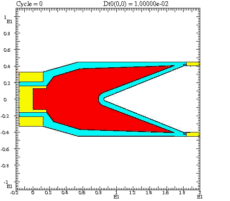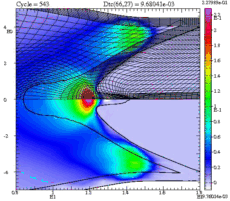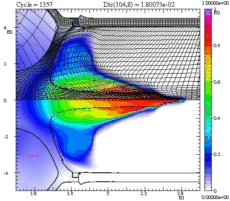Comparing hydrodynamic computer model predictions against accurate data acquired during the detonation of real-world precision-built devices is an extremely powerful technique for quickly optimizing the design of explosive or propellant driven systems. As with explosives testing, becoming proficient at computer modeling requires experience. Almost anyone can get an answer from the software, but getting an answer that matches reality requires both detailed knowledge of the software, and accurate data from experiments to allow comparison of the model to the real-world. We're experts at design, fabrication, and explosives testing, but we rely on strategic partnerships with experienced hydrocode modelers to provide high fidelity calculations. These modelers learned their trade by modeling a wide variety of systems in the government research environment. This modeling expertise and our advanced testing services are available separately, or as an integrated package. If you'd like to learn more about hydrodynamic modeling software, or only need modeling services, you can contact us and we'll provide a referral, or contact one of our strategic modeling partners directly, such as Hydrosoft International and Jay B. Chase.
2-D & 3-D Modeling
In many cases the device being modeled has some type of symmetry that can be exploited to simplify the modeling to only 2 dimensions, thus saving a lot of computational effort. Conical or hemispherical shaped charges are excellent examples. In other cases, however, 3-D hydrocodes must be used to accurately model all of the phenomena at work in the operation of the device. From our list of strategic modeling partners, we select those with the proper tools and expertise to analyze the performance of your energetic systems.
Blending Model & Data
Comparison of computer models to physical data only works well if the model accurately matches the as-built hardware and all aspects of the test configuration, such as sensor locations and signal timing. Even for components that don't require extreme precision in production, it's important to exercise precision during the test and optimization phase so that the effects of production variations can be properly predicted via the computer models. That's why we use CAD/CAM design and fabrication tools for virtually all of our test device and fixture fabrication. Integrating potential fielding issues into component design and modeling efforts on the front-end of a project can lower overall development costs by ensuring that design and test intent are included in the modeling effort.
Our Modeling Partners
Modern hydrodynamic computer codes are complex, with many internal "knobs" that control various aspects of how the model executes. In addition, for any given material there are many possible equations of state that might be used in the model. Not all combinations of these parameters will result in an accurate model. The software will usually produce a result - but the result doesn't necessarily match the performance of the real-world system. Learning to use computer hydrocodes properly is a long-term effort requiring not only a lot of time, but a lot of opportunity to compare calculations against real-world data. The strategic partners selected by HSI to complement our testing services are all professionals who come from the government research environment with years of experience in modeling explosives and propellent driven systems. They've learned the "tricks of the trade" needed to turn hydrocode calculations into useful models of real-world systems.




